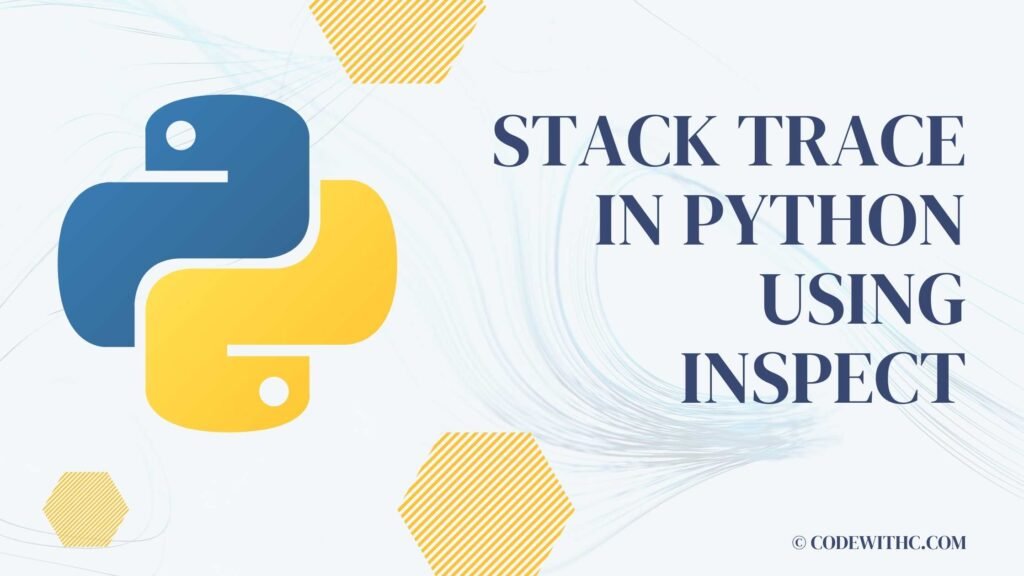Stack Trace in Python using Inspect. The stack trace is a debugging technique where you can see the method calls that are made by a program to get from a given point in the code to a point in the code where an error occurs.
The first step is to be able to get a stack trace. This can be done by looking at the variables in the code. You can print the variables out and then add print statements to check the values of the variables. This will work if the errors that occur are in the print statements themselves.

You need to know the value of the variable that the program is trying to print out so you can make sure it is in fact printed out. To do this you can use the inspect module.
- You can import the module like this import inspect.
- Now we have to look at the function call and print out the arguments.
- To do this you use the function signature.
- You can use the format function to print out the arguments.
- To print the variable name of the arguments use the args variable.
- Finally you need to print out the value of the variable.
- You use the vars() function to get the list of all the variables in the function.
- You can then loop through the list to find the name and value of the variable.
Once you have the name and value of the variable you can use the setattr function to set the value of the variable.
Finally you need to print out the value of the variable and that is done using the print function.
Stack trace is used to display a call stack and to debug exceptions. A stack trace contains the sequence of frames or methods that were executed when an exception occurred. This is usually done to help in understanding what went wrong.
Python inspect module has been designed to facilitate handling these traces, and it allows us to find out exactly what caused the exception. In this tutorial, we will see what are the details of stack trace in Python using inspect module.
How to use inspect
import inspect
inspect.getouterframes(Exception)
print(inspect.currentframe().f_back.f_code)
print(inspect.currentframe().f_back.f_globals)
print(inspect.currentframe().f_back.f_locals)
What is Stack Trace in Python using inspect?
A stack trace is a set of information that is shown when an exception is thrown. For example, suppose a method is defined like the following:
def myfunction(self):
try:
raise ValueError(‘This is an error message.’)
except Exception:
pass
In this case, the code prints the following stack trace:
File “C:\Users\xyz\Desktop\exceptions.py”, line 7, in myfunction
raise ValueError(‘This is an error message.’)
ValueError: This is an error message.
In this case, the trace shows that the exception was raised due to the call to raise statement. The line that raised the exception is on the same line in which the function definition is.
In the above stack trace, the frame shows the line number of the source code where the exception is raised. The line number is determined from the line number in the file where the exception is raised. The frame contains the following information:
Note that the information displayed is very basic. There are additional attributes available that show more information about the stack frame. However, it is generally not necessary to access them directly.
The inspect module provides a powerful API to obtain the information required to perform debugging of exceptions. The inspect.getouterframes() function returns a list of tuples containing information about the frames and methods that were called when an exception was raised. The information includes:
print(inspect.getouterframes(Exception))[0][1]
print(inspect.currentframe().f_code)
print(inspect.currentframe().f_globals)
print(inspect.currentframe().f_locals)
A stack trace contains the sequence of frames or methods that were executed when an exception occurred. This is usually done to help in understanding what went wrong.
What is inspect.getouterframes?
The getouterframes() function allows us to obtain the sequence of frames and methods that were called when an exception occurred.
import inspect
def first():
second()
def second():
for info in inspect.stack():
#print(info)
#FrameInfo(
# frame=,
# filename='stack_trace.py',
# lineno=8,
# function='second',
# code_context=[' for level in
inspect.stack():\n'],
# index=0)
#print(info.frame)
print(info.filename)
print(info.lineno)
print(info.function)
print(info.code_context)
print('')
def main():
first()
if name == ' main ':
main()
stack_trace.py
8
second
[' for info in inspect.stack():\n']
stack_trace.py
4
first
[' second()\n']
stack_trace.py
26
main
[' first()\n']
stack_trace.py
30
[' main()\n']






